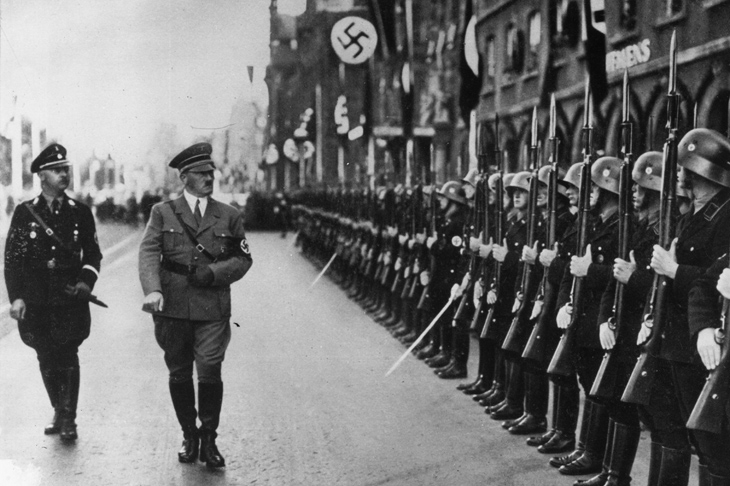We don’t usually think of Hitler’s hated henchman Heinrich Himmler, architect of the Holocaust of European Jewry, as a comic turn, but the diary of Admiral Sir Barry Domvile, a former chief of British Naval Intelligence and fanatical admirer of Nazi Germany, proves otherwise.
Domvile’s description of his visit to Himmler’s ‘hunting box’ high in the Bavarian Alps in 1935, reproduced in Julia Boyd’s fascinating book, is a treasury of thigh-slapping humour, including hearing Himmler wake him at 3.20 a.m. with his rendition of ‘God Save the King’; complaints about the Reichsführer’s primitive ‘bog’ — a deep hole in the ground; and finishing with a ‘regular Bavarian evening… much leaping, crying and slapping of bums, soles of feet, thighs etc. and a pretence of lifting the girls’ skirts, reminiscent of Highland reels’. ‘HH’, Domvile concludes, was ‘very charming’.
No less droll is the eyewitness account by Kay Smith, an American diplomat’s wife, who saw that inveterate show-off Hermann Goering — second only to Hitler in the Reich’s heirarchy — demonstrate his affinity with his pet lion Augie by letting the animal lick his face before an audience of visiting VIPs. Then the poor creature, startled by an aide’s sudden laugh, ‘let loose a flood of yellow urine all over [Goering’s] snow white uniform… the lion was led away… we all laughed pleasantly’.
Such surreal scenes pepper Boyd’s deep trawl of travellers’ tales from the scores of visitors she quotes who were drawn to the ‘new Germany’ in the 1930s. The tourists fell into three groups: most were simply curious to discover for themselves what the much vaunted or reviled regime was really like; some were enthusiasts who saw nothing but good in the Hitlerian state, determinedly closing their eyes to its obviously sinister side; and others were committed anti-Nazis, who came to confirm their loathing of a society hell-bent on indoctrination, racial persecution and war.
Few minds were changed by their visits. Hitler fans like Domvile, the dementedly Führer-struck Unity Mitford, and famous sympathisers such as the American aviator Charles Lindbergh, the Norwegian Nobel literature laureate Knut Hamsun, and the British nature writer Henry Williamson, came away convinced that the Führer was creating a utopia peopled by happy and healthy youngsters marching down an autobahn towards a radiant future.
The only pro-Nazi cited by Boyd who was ‘turned’ by the reality of his experience was the verbose American novelist Thomas Wolfe. The scales dropped from his eyes when, leaving Germany, he saw a Jew stripped of all he possessed by a bullying Nazi official at the frontier.
What is most striking in Boyd’s examples ,though, is the willing suspension of doubts even when visitors faced such savage atrocities as Kristallnacht, the brutal burning and trashing of Jewish synagogues, homes and stores; or allowed themselves to believe that the contented and well-fed inmates of Dachau concentration camp they were shown were real prisoners instead of the SS guards in disguise that they actually were. Such sights were the Potemkin villages of Nazi Germany: shop windows giving an entirely false picture to gullible outsiders of the true house of horrors within.
An enduring mystery still stubbornly clinging to Hitler, despite the reams of studies devoted to him, is just how this shabby back-street guttersnipe magicked himself within a decade into the God-like dictator of a superstate, worshipped alike by the overwhelming majority of Germans and the many bedazzled foreigners Boyd has found.
Part of the answer to the puzzle is provided by David King’s vivid account of the 1923 Munich beer hall putsch — Hitler’s farcically abortive attempt to seize power by violence ten years before he won it legally. The first part of King’s book is a fast moving narrative of the putsch itself, while the second is a detailed account of Hitler’s subsequent trial for treason, based on Bavarian court records hitherto somewhat neglected by historians.
Aided by a lenient judge, Hitler transformed the trial into a performance with himself as the star. Turning the case against him inside out, he became the prosecutor lambasting the real traitors, the politicians who he claimed had betrayed the Fatherland. By successfully portraying his botched putsch as a blood sacrifice, and himself as martyred hero, Hitler grabbed national and international attention and set the scene for his rapid ascent.
Both these books offer startling insights into aspects of Hitler and Nazism that have previously been under-reported. The subtitles of both are misleading — fascism and Nazism being different beasts, and the rise of Nazi Germany coming more than ten years after Hitler’s treason trial. But that does not detract from their value in refreshing the hackneyed and rather dusty history of the astounding Hitler phenomenon.






Comments